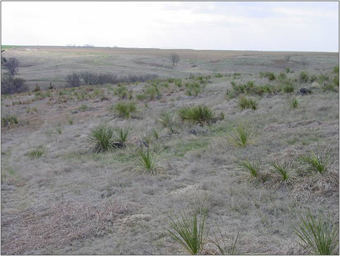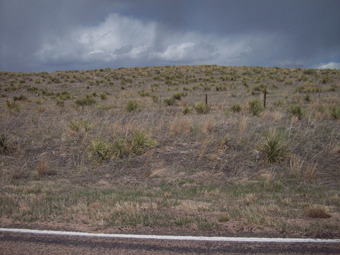G2086
Managing Soapweed Yucca
Soapweed yucca can infest pastures and rangeland, reducing beneficial plant populations and livestock production. Learn the history, biology, and management of this plant and its potential impact.
Stephen L. Young, Extension Weed Ecologist
Noel L. Mues, Extension Educator
Douglas L. Anderson, Extension Educator
|
History and Biology
Soapweed yucca (Yucca glauca Nutt.), hereafter referred to as yucca, is a native perennial shrub found throughout much of Nebraska and the Great Plains (Figure 1) including central Canada and the Texas Panhandle. Prior to European settlement, Native Americans used yucca for food, fiber, and shampoo. It is used in landscapes as an ornamental, but generally is considered a nuisance in pastures, ranges, and rights-of-way. It can reach densities of up to 2,000 plants per acre.
Moderate to dense populations of yucca can decrease the quality and availability of forage, which negatively affects livestock and wildlife. The erect, upright leaves of yucca can injure animals and humans. Yucca are hardy plants and well adapted to surviving drought, fire, and grazing. The root system is well adapted to water storage, quickly consuming the rainfall that the leaf structure directs toward the center of the whorl. Its extensive taproot and rhizomes allow it to regenerate even after completely losing the top of the plant (Figure 2).
Yucca is classified in the Agavaceae family. Among the many members of the Agavaceae are the Hosta genus containing common ornamentals and the Agave genus that includes sisal fiber. Several species of yucca exist, including soaptree yucca (Y. elata), which is found in Colorado, New Mexico, and Arizona. Other yucca species include Spanish Bayonet (Y. aloifolia) and Curve-Leaf Yucca (Y. recurvifolia). Adam’s Needle (Y. filamentosa) and soapweed yucca are the only species found in Nebraska. Yucca species are evergreen and most prefer medium to coarse soils in arid to semi-arid climates.
The seasonal development of established yucca plants begins in May with flowering, followed by fruit ripening in July, and finally seed dispersal in September. New plants are produced either by seed or ramets, which are clones of the parent plant produced from lateral buds or rhizomes near rosettes. Typically, yucca colonizes a new site by seed, after which vegetative reproduction (i.e., ramets) is the primary means of establishment and can lead to heavy infestations.
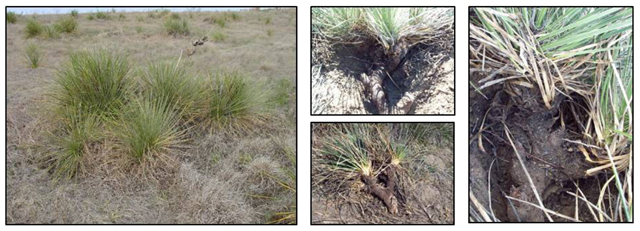 |
| Figure 2. Yucca parent population (left) with offspring plants and exposed rhizomes. |
Identification
Yucca is easily distinguished by its large, erect leaves and clumping growth habit (Figure 3). Although it may appear to be related to cactus, it is actually not closely related, nor is it even a succulent plant. Plants may grow as high as 4 feet and tap roots as deep as 20 feet.
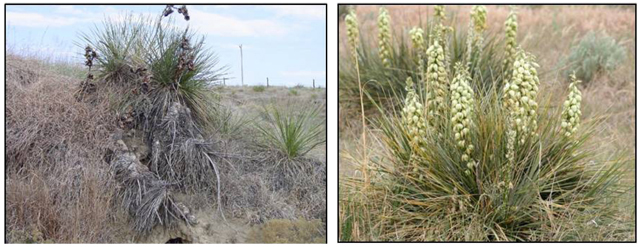 |
|
| Figure 3a. Yucca plant. | Figure 3b. Flowers. (Courtesy of www.estesbog.com) |
Yucca flowers are greenish-white to cream-colored and may have a slight tinge of purple.
Flowering occurs from May through July in a raceme that extends above the main plant canopy. The circular or triangular, black, semiglossy seeds are encapsulated in a pod that is cylindrical and elongated (Figure 4). The leaves are closely alternate and radiate from the stem in a whorl shape with new leaves appearing in the center. The blades are simple, linear and form a tip, which is a hard, sharp point. The blue-green coloration of the leaves is an important survival adaptation, allowing the plant to reflect heat during dry periods.
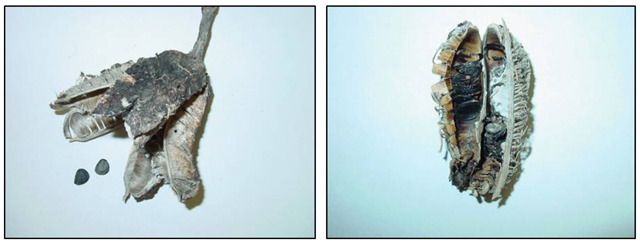 |
| Figure 4. Yucca flower pod and seeds. |
|
Impacts of Yucca
Dense yucca populations can infest pastures and rangelands (Figure 5), reducing production of livestock and desirable plant types. The loss of native or desirable plants is difficult to assign a value, but can be seen indirectly through reduced wildlife. In some situations, yucca can provide protection for small mammals and birds, but in general, it offers little value for larger animals, such as elk, deer, and pronghorn. The nutritional content of yucca is 1-2 percent crude fat, 3-5 percent protein, and 14-16 percent fiber.
The occurrence of individual yucca plants can be beneficial when surrounded by a mix of native or desirable plant types. Birds and small mammals use yucca for food, shade, and nesting habitat year round. If forced, cattle, deer, and pronghorn will eat the flowers and fruits and occasionally rely on the stems and leaves in winter and during severe drought.
Distribution
Yucca occurs in rangeland and prairies across Nebraska, especially in the Sandhills region (Figure 6). Distribution in Nebraska is largely dependent on precipitation as yucca prefers the drier western regions of the state. In wetter areas, particularly in southeast Nebraska, more acres are in production agriculture, which is unfavorable to yucca.
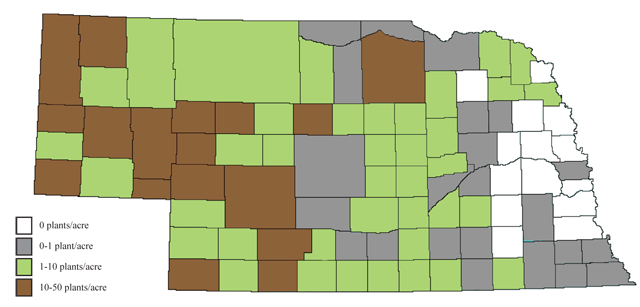 |
| Figure 6. Extent of infestation in rangeland or pasture areas with yucca, based on a survey of Nebraska county weed superintendents and University of Nebraska–Lincoln extension educators. |
Management of Yucca
Several tools, including mechanical, chemical, and cultural methods have been analyzed for controlling yucca.
Mechanical
Yucca can be mowed or shredded with high powered equipment; however, the long-term success of this practice is limited since yucca can regrow from the rhizomes and taproot. A digger or ripper can completely remove yucca, but this can be costly as it requires significant time and fuel.
Chemical
Effective control of yucca with herbicides is highly dependent on timing and placement. A directed spray using Remedy® and diesel fuel or vegetable oil is effective for controlling yucca. By mixing Remedy (15 percent) with diesel fuel or vegetable oil (85 percent), an application to the center of the whorl with a single spray nozzle (5500-X1) will allow the herbicide to be absorbed directly into the meristematic tissue for complete uptake. It is important to add the herbicide to the spray tank first and then add enough oil to get the total volume desired. In addition, the duration of application to the whorl must be for at least two seconds. Use a timer or slowly count (e.g., “21, 22”) to ensure a two-second application. Remedy RTU, which is a “pre-mix” of Remedy and vegetable oil is also available at a higher price.
| Table I. Yucca control with whorl spray herbicide applications. | ||||
| Herbicide* | Proportioned |
2 Months
After Treatment |
12 Months
After Treatment |
30 Months After Treatment |
% Visual Control |
||||
| Remedy® (15%) + diesel fuel (85%) | 19 oz/1 gal |
100 |
100 |
100 |
| *All treatments applied with 5500-X1 nozzle and Hi-Light blue spray marking dye. | ||||
The whorl spray with Remedy plus diesel fuel is most effective if applied during the growing season. At up to two months after treatment (MAT), control was 100 percent (Table I). After two years, excellent control was achieved with this mix of chemical and diesel fuel (Figure 7). Other herbicides are labeled (Cimarron® MAX, Velpar® L) or have been tested (Tordon® 22K) for control of yucca, but reports indicate inadequate control (less than 90 percent) based on application method or active ingredient.
 |
| Figure 7. Control of yucca with Remedy® and diesel fuel after 2 months (a), 12 months (b), and 30 months (c). |
Broadcast applications of herbicides, such as Roundup Ultra®, Reward®, and Roundup Ultra or Reward® plus Ally® had varying rates of control at eight weeks after treatment. Control of yucca was 48 percent with 6 quarts of Roundup Ultra®, which was greater than for Reward® (Table II). Adding Ally® improved control; however, it was still less than 70 percent regardless of timing.
| Table II. Yucca control with broadcast herbicide applications. | |||
| Herbicide* | Rate/AC |
8 Weeks after Treatment |
15 Weeks after Treatment |
% Visual Control |
|||
| Roundup Ultra® | 6 qt |
48 |
54 |
| Reward® | 1 qt |
0 |
0 |
| Roundup Ultra® + Ally® | 6 qt + 0.75 oz |
69 |
65 |
| Reward® + Ally® | 1 qt + 0.75 oz |
63 |
63 |
| LSD (0.05) | 16 |
13 |
|
| *All treatments applied with a non-ionic surfactant at 1.0 percent (v/v). | |||
In summary, broadcast herbicide applications are less than satisfactory for the effective control of yucca and can cause considerable damage to surrounding grasses and forbs. Spot treatments are usually a better control option for yucca.
Cultural
The use of cultural techniques, such as hand removal and fire, to control yucca are largely ineffective, except in localized areas. Yucca can recover quickly from fire by re-sprouting. In most cases, fire can actually stimulate growth with up to a 17 percent increase in the number of post-fire sprouts per plant. Fire intensity plays a role in survivorship and recovery of yucca, with low-intensity burns allowing greater survival. In rare cases of severe fires, yucca populations can be severely reduced due to damaged plant and seed (Table III).
| Table III. Yucca seed germination at varying temperatures. | |||||||
Control |
2 hours of heat |
5 minutes of heat |
|||||
| Temperature (F) | 72 |
180 |
190 |
190 |
210 |
230 |
250 |
| Germination (%) | 79 |
57 |
42 |
41 |
59 |
28 |
3 |
Biological
The yucca moth (Tegeticulla yuccasella) is essential for pollination of yucca. After it lays an egg on the ovary of the yucca flower, the moth moves to the stigma and rubs a ball of pollen on the pollen receptors. After egg hatch, the larvae damage the developing seed. The extent of damage depends on how many eggs were laid within the yucca flower. Typically, there are far more seeds than larvae so the yucca moth is largely ineffective as a biological control. The moth is beneficial, however, as it is the only pollinator of yucca, and yucca species are the only hosts for the moth larvae.
In addition, cattle grazing is a form of biological control often used in winter and sometimes in summer; however, summer grazing can cause an increase in yucca. Researchers at the University of Nebraska–Lincoln West Central Research and Extension Center in North Platte are studying the extent to which cattle grazing is detrimental to yucca.
Revegetation
An effective long-term control solution is the removal of yucca and replacement with native perennial plant species. Although combining one of the previously mentioned control tools with a planting of native perennial grasses can be expensive, the economic returns and environmental benefits from increased productivity and habitat diversity, respectively, can be significant.
Summary
Yucca is difficult to control in pasture and rangeland situations, but with the right treatment(s) that removes or kills both aboveground and belowground structures, success can be achieved. In the case of chemical control, care must be taken to match the size of yucca with the herbicide rate and mixture needed for effective control.
Weed control with herbicides alone often results in reinfestation of the pasture or rangeland. Without plans to revegetate following the elimination of yucca, repeat applications will be necessary to provide control for any length of time. Long-term weed control requires a combination of treatments that promote healthy, dense forage that can successfully compete with and prevent the establishment of yucca.
This publication has been peer reviewed.
Disclaimer Reference to commercial products or trade names is made with the understanding that no discrimination is intended of those not mentioned and no endorsement by University of Nebraska–Lincoln Extension is implied for those mentioned. |
Visit the University of Nebraska–Lincoln Extension Publications website for more publications.
Index: Range and Forage
Pasture Management
Issued May 2011
